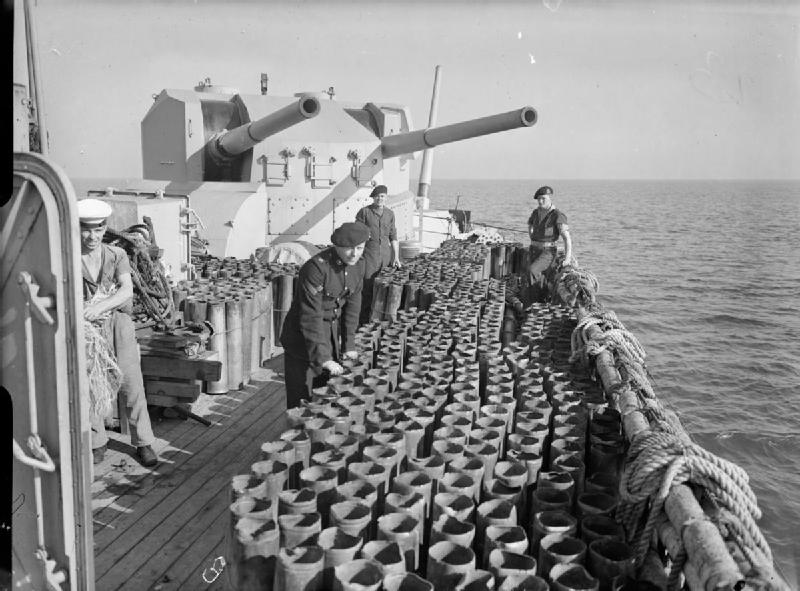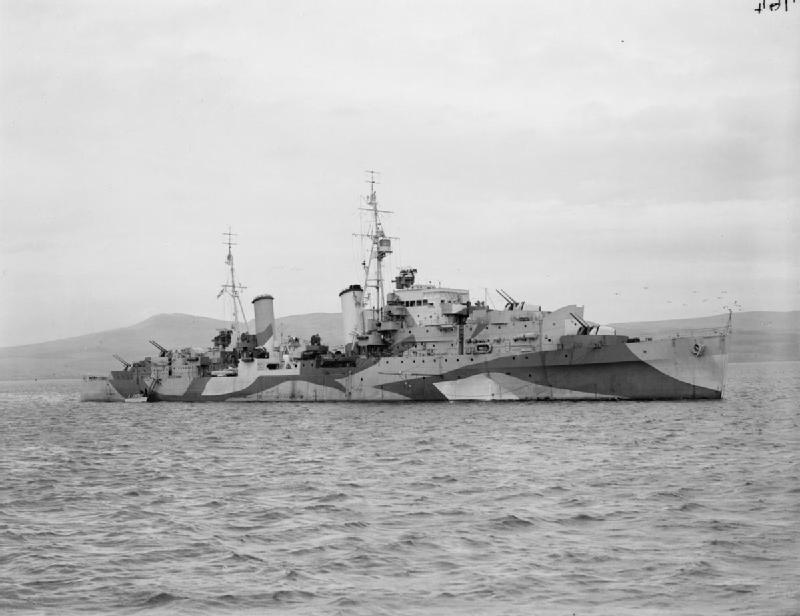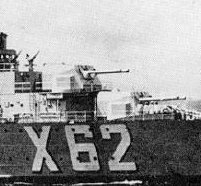|
QF 5.25-inch Naval Gun
The QF 5.25-inch Mark I gun was the heaviest dual-purpose gun used by the Royal Navy during the Second World War. Although considered less than completely successful, it saw extensive service. 267 guns were built. Design Unlike its French and Italian contemporaries of similar size the QF 5.25-inch gun was designed as dual-purpose equipment capable of engaging both aircraft and surface targets. Combining the secondary and heavy anti-aircraft armament allowed a significant weight savings for the s, which were designed to meet the Washington Naval Treaty limit of 35,000 tons. The gun fired an shell, which was considered the largest that a gun crew could easily handle while still having the rate of fire needed for anti-aircraft use. In 1944, VT-fuzed shells became available, making the gun significantly more effective against aircraft. The 5.25-inch gun was carried in Mk I twin mountings by the ''King George V'' class and in Mk II twin mountings on nine of the first eleven an ... [...More Info...] [...Related Items...] OR: [Wikipedia] [Google] [Baidu] |
HMS Sirius (82)
HMS ''Sirius'' was a light cruiser of the Royal Navy. She was built by Portsmouth Dockyard (Portsmouth, United Kingdom), with the keel being laid down on 6 April 1938. She was launched on 18 September 1940, and commissioned 6 May 1942. History ''Sirius''s completion was delayed due to German bombing at Portsmouth Dockyard so she was completed at Scotts Shipbuilding and Engineering Company (Greenock, Scotland). On completion she initially joined the Home Fleet, and was then assigned to operate in the Mediterranean in August for Operation Pedestal, the supply of Malta. She was then ordered to the South Atlantic to patrol against Axis blockade runners on the Far East route, returning to Gibraltar in November for Operation Torch, the North African landings. As part of Force Q at Bone in December she harried Axis convoys to and from Tunisia until the Axis surrender in North Africa. Force Q, including ''Sirius'', took part in the last naval battle held in the Mediterranean Sea dur ... [...More Info...] [...Related Items...] OR: [Wikipedia] [Google] [Baidu] |
Proximity Fuze
A proximity fuze (or fuse) is a Fuze (munitions), fuze that detonates an Explosive material, explosive device automatically when the distance to the target becomes smaller than a predetermined value. Proximity fuzes are designed for targets such as planes, missiles, ships at sea, and ground forces. They provide a more sophisticated trigger mechanism than the common contact fuze or timed fuze. It is estimated that it increases the lethality by 5 to 10 times, compared to these other fuzes. Background Before the invention of the proximity fuze, detonation was induced by direct contact, a timer set at launch or an altimeter. All of these earlier methods have disadvantages. The probability of a direct hit on a small moving target is low; a shell that just misses the target will not explode. A time- or height-triggered fuze requires good prediction by the gunner and accurate timing by the fuze. If either is wrong, then even accurately aimed shells may explode harmlessly before reaching ... [...More Info...] [...Related Items...] OR: [Wikipedia] [Google] [Baidu] |
Karachi
Karachi (; ur, ; ; ) is the most populous city in Pakistan and 12th most populous city in the world, with a population of over 20 million. It is situated at the southern tip of the country along the Arabian Sea coast. It is the former capital of Pakistan and capital of the province of Sindh. Ranked as a beta-global city, it is Pakistan's premier industrial and financial centre, with an estimated GDP of over $200 billion ( PPP) . Karachi paid $9billion (25% of whole country) as tax during fiscal year July 2021 to May 2022 according to FBR report. Karachi is Pakistan's most cosmopolitan city, linguistically, ethnically, and religiously diverse, as well as one of Pakistan's most secular and socially liberal cities. Karachi serves as a transport hub, and contains Pakistan’s two largest seaports, the Port of Karachi and Port Qasim, as well as Pakistan's busiest airport, Jinnah International Airport. Karachi is also a media center, home to news channels, film and fashi ... [...More Info...] [...Related Items...] OR: [Wikipedia] [Google] [Baidu] |
Naval Headquarters (Pakistan) ...
Naval Headquarters (NHQ) is the headquarters of Pakistan Navy established in 1947 in Karachi. On 15 March 1975, it was moved to Islamabad. Initially it was housed in a government secretariat building of sector G-6 in Islamabad and was later shifted to sector E-8.See also * Joint Staff Headquarters (Pakistan) * Air Headquarters (Pakistan Air Force) * General Headquarters (Pakistan Army) References {{Pakistan Navy Pakistan Navy Islamabad Military headquarters in Pakistan Pakistan Pakistan ( ur, ), officially the Islamic Republic of Pakistan ( ur, , label=none), is a country in South Asia. It is the world's List of countries and dependencies by population, fifth-most populous country, with a population of almost 24 ... [...More Info...] [...Related Items...] OR: [Wikipedia] [Google] [Baidu] |
Twin 5
Twins are two offspring produced by the same pregnancy.MedicineNet > Definition of TwinLast Editorial Review: 19 June 2000 Twins can be either ''monozygotic'' ('identical'), meaning that they develop from one zygote, which splits and forms two embryos, or ''dizygotic'' ('non-identical' or 'fraternal'), meaning that each twin develops from a separate egg and each egg is fertilized by its own sperm cell. Since identical twins develop from one zygote, they will share the same sex, while fraternal twins may or may not. In rare cases twins can have the same mother and different fathers (heteropaternal superfecundation). In contrast, a fetus that develops alone in the womb (the much more common case, in humans) is called a ''singleton'', and the general term for one offspring of a multiple birth is a ''multiple''. Unrelated look-alikes whose resemblance parallels that of twins are referred to as doppelgängers. Statistics The human twin birth rate in the United States rose 76% from ... [...More Info...] [...Related Items...] OR: [Wikipedia] [Google] [Baidu] |
Inside 5
Inside may refer to: * Insider, a member of any group of people of limited number and generally restricted access Film * ''Inside'' (1996 film), an American television film directed by Arthur Penn and starring Eric Stoltz * ''Inside'' (2002 film), a Canadian prison drama film * ''Inside'' (2006 film), an American thriller film starring Nicholas D'Agosto and Leighton Meester * ''Inside'' (2007 film), originally ''À l'intérieur'', a French horror film directed by Alexandre Bustillo and Julien Maury ** ''Inside'' (2016 film), a 2016 Spanish-American film remake of the 2007 film * ''Inside'' (2011 film), an American social film * ''Inside'' (2012 film), an American horror film * ''Inside'' (2013 film), a Turkish drama film * '' Bo Burnham: Inside'', a 2021 American comedy special * ''Inside'' (2023 film), an upcoming film starring Willem Dafoe Television * "Inside" (''American Horror Story''), an episode of the tenth season of ''American Horror Story'' Music Albums * ... [...More Info...] [...Related Items...] OR: [Wikipedia] [Google] [Baidu] |
HACS
High Angle Control System (HACS) was a British anti-aircraft fire-control system employed by the Royal Navy from 1931 and used widely during World War II. HACS calculated the necessary deflection required to place an explosive shell in the location of a target flying at a known height, bearing and speed. Early history The HACS was first proposed in the 1920s and began to appear on Royal Navy (RN) ships in January 1930, when HACS I went to sea in . HACS I did not have any stabilization or power assist for director training. HACS III which appeared in 1935, had provision for stabilization, was hydraulically driven, featured much improved data transmission and it introduced the HACS III Table. The HACS III table (computer) had numerous improvements including raising maximum target speed to 350 knots, continuous automatic fuze prediction, improved geometry in the deflection Screen, and provisions for gyro inputs to provide stabilization of data received from the director. The HACS w ... [...More Info...] [...Related Items...] OR: [Wikipedia] [Google] [Baidu] |
Sinking Of Prince Of Wales And Repulse
The sinking of ''Prince of Wales'' and ''Repulse'' was a naval engagement in World War II, as part of the war in the Pacific, that took place on 10 December 1941 in the South China Sea off the east coast of the British colonies of Malaya (present-day Malaysia) and the Straits Settlements (present-day Singapore and its coastal towns), east of Kuantan, Pahang. The Royal Navy battleship and battlecruiser were sunk by land-based bombers and torpedo bombers of the Imperial Japanese Navy. In Japan, the engagement was referred to as the . The objective of Force Z, which consisted of one battleship, one battlecruiser and four destroyers, was to intercept the Japanese invasion fleet in the South China Sea north of Malaya. The task force sailed without air support. Although the British had a close encounter with Japanese heavy surface units, the force failed to find and destroy the main convoy. On their return to Singapore they were attacked in open waters and sunk by long-ran ... [...More Info...] [...Related Items...] OR: [Wikipedia] [Google] [Baidu] |
Operation Halberd
Operation Halberd was a British naval operation that took place on 27 September 1941, during the Second World War. The British were attempting to deliver a convoy from Gibraltar to Malta. The convoy was escorted by several battleships and an aircraft carrier, to deter interference from the Italian surface fleet, while a close escort of cruisers and destroyers provided an anti-aircraft screen. The Italian fleet sortied after the convoy was detected, but turned back after learning the strength of the escorting force. Air attacks by Italian bombers and fighters damaged several ships, and forced one of the merchant vessels to be scuttled. The rest of the convoy arrived at Malta and discharged their cargo. The convoy Operation Halberd was at the time the largest Malta resupply effort of the war. Nine merchant ships carrying 81,000 tons of military equipment and supplies sailed from Liverpool on 16 September and from the Clyde on 17 September as part of convoy WS (Winston Specials) 11 ... [...More Info...] [...Related Items...] OR: [Wikipedia] [Google] [Baidu] |
135 Mm /45 Italian Naval Gun
The Cannone da 135/45 OTO 1937 was a 135 mm (5.3 in) 45-caliber naval gun built for the Regia Marina in the late 1930s. Built as a response to the French Canon de 138 mm Modèle 1929, it was meant to have the same range as the widespread 120 mm gun, but with less muzzle velocity and less dispersion. Description This gun was of loose barrel, jacket and bracket ring, with a horizontal, hand-operated sliding block. The mountings, all with individual cradles for each gun, were either triple (on battleships) or double, with electrical-powered ramming (which, however, was too weak for elevations above 30°, which therefore required hand loading, which rendered the gun unsuitable for anti-aircraft use). The gun fired both AP and HE shells, all weighing 32.7 kg (72.1 lb), at a muzzle velocity of 825 M/S (2,707 F/S). Service The triple mountings were used on the s as a secondary battery (with each having four turrets); four double mountings each were fitted on the thr ... [...More Info...] [...Related Items...] OR: [Wikipedia] [Google] [Baidu] |
Canon De 138 mm Modèle 1929
The Canon de 138 mm Modèle 1929 was a medium-calibre naval gun of the French Navy used during World War II. It was used on the large destroyers (''contre-torpilleurs'') of the and classes. Description The 50-caliber ''Mle 1929'' was a lengthened version of the Modèle 1927. It used the semi-automatic action of the older gun as well as its horizontal sliding-block breech. It had an autofretted monobloc barrel as well. It weighed .Campbell, p. 296 Mountings Modèle 1929 The ''Mle 1929'' gun was used in single, hand-worked and trained, center-pivot mountings that weighed approximately that were fitted with a thick gun shield A U.S. Marine manning an M240 machine gun equipped with a gun shield A gun shield is a flat (or sometimes curved) piece of armor designed to be mounted on a crew-served weapon such as a machine gun, automatic grenade launcher, or artillery piece .... The mount could depress -10° and elevate to +30°, which gave it a maximum range of . Ammunitio ... [...More Info...] [...Related Items...] OR: [Wikipedia] [Google] [Baidu] |


.jpg)




